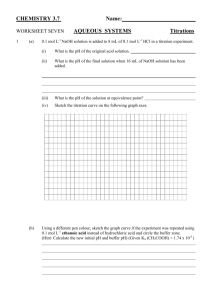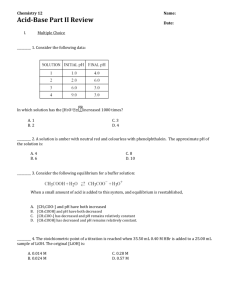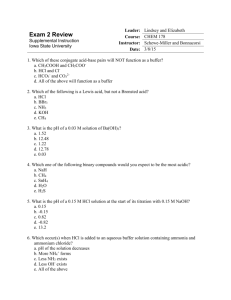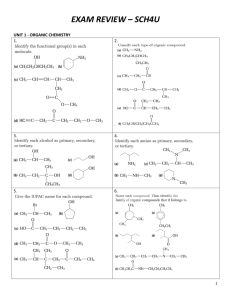Applications of Acid – Base Reactions Notes
advertisement
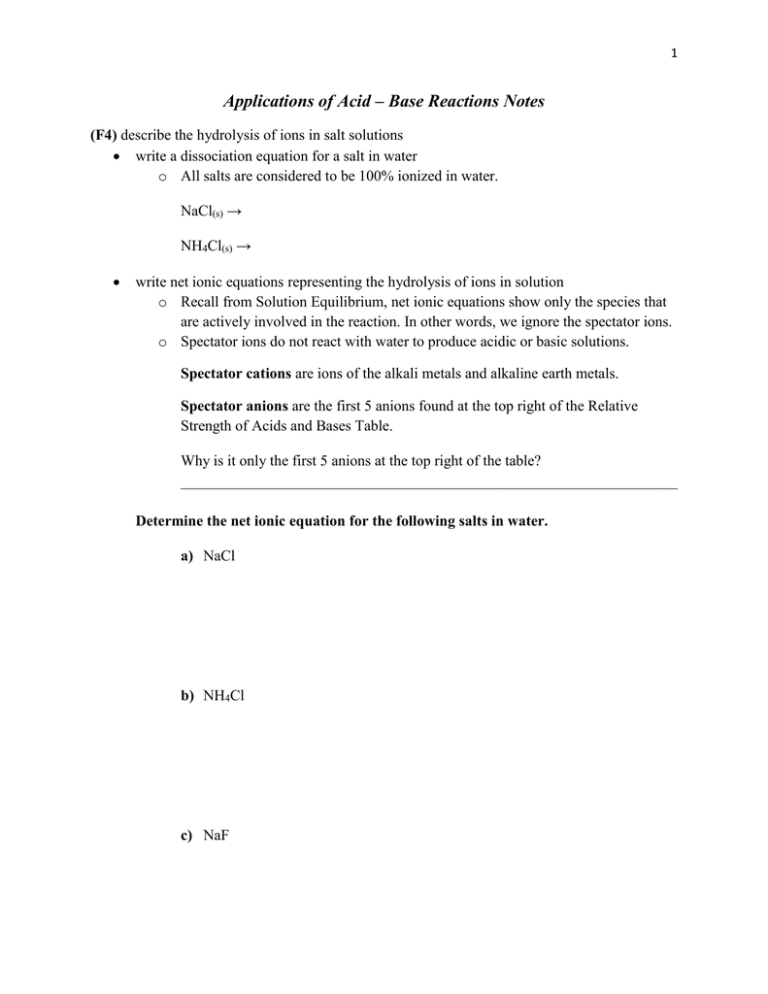
1 Applications of Acid – Base Reactions Notes (F4) describe the hydrolysis of ions in salt solutions write a dissociation equation for a salt in water o All salts are considered to be 100% ionized in water. NaCl(s) → NH4Cl(s) → write net ionic equations representing the hydrolysis of ions in solution o Recall from Solution Equilibrium, net ionic equations show only the species that are actively involved in the reaction. In other words, we ignore the spectator ions. o Spectator ions do not react with water to produce acidic or basic solutions. Spectator cations are ions of the alkali metals and alkaline earth metals. Spectator anions are the first 5 anions found at the top right of the Relative Strength of Acids and Bases Table. Why is it only the first 5 anions at the top right of the table? __________________________________________________________________ Determine the net ionic equation for the following salts in water. a) NaCl b) NH4Cl c) NaF 2 (F5) analyse the extent of hydrolysis in salt solutions predict whether a salt solution would be acidic, basic, or neutral (compare Ka and Kb values, where necessary) Predict whether the following salt solutions will be acidic, basic, or neutral. a) NH4NO2 b) Fe(H2O)6Cl3 c) Al(H2O)5(OH)(NO3)2 determine whether an amphiprotic ion will act as a base or an acid in solution (compare Ka and Kb values, where necessary) Determine whether the salt, NaHC2O4, will act as an acid or base in water. 3 calculate the pH of a salt solution from relevant data, assuming that the predominant hydrolysis reaction is the only reaction determining the pH o These type of problems involve the “ST, ∆, EQ” tables. If Ka = 1.8 x 10-5 for CH3COOH, what is the pH of a 0.500 M solution of CH3COOH? 4 If pH = 1.70 for a 0.100 M solution of an unknown weak acid, HA, what is Ka for HA? 5 What mass of NH4Cl will produce 1.50 L of a solution having a pH of 4.75? 6 Calculations Involving Kb What is the pH of a 0.10 M solution of NaCN? 7 The pOH of a 0.50 M solution of the weak acid HA is 10.64. What is the Kb for A-? 8 (F2) describe an indicator as an equilibrium system describe an indicator as a mixture of a weak acid and its conjugate base, each with distinguishing colours describe the term transition point of an indicator, including the conditions that exist in the equilibrium system describe the shift in equilibrium and resulting colour changes as an acid or a base is added to an indicator o An indicator is a weak organic acid or base with different colours for its conjugate acid and base form. o Indicators are often complex molecules so we use abbreviations to represent their names (for example HIn denotes acid and an indicator). Consider the indicator HIn. a) Determine what happens when it is put in water. b) Determine what happens when the solution becomes acidic. c) Determine what happens when the solution becomes basic. d) Determine the end point for this indicator. 9 (F3) perform and interpret calculations involving the pH in a solution and Ka for an indicator predict the approximate pH at the transition point using the Ka value of an indicator predict the approximate Ka value for an indicator given the approximate pH range of the colour change Ethyl orange is red at pH < 3.4, yellow at pH > 4.8 and an intermediate orange at pH = 4.1. What is the approximate value of Ka for methyl orange? Alizarin Yellow R changes from yellow to red at pH = 11.0. If the Aliz- ion is red, what colour is Alizarin Yellow R in 1 x 10-5 M NaOH? match an indicator’s colour in a solution with an approximate pH, using a table of indicators o In your data booklets, there is a table called “ACID – BASE INDICATORS” o Refer to this table to determine an indicator’s colour at a certain pH. Universal Indicator – an indicator solution which changes colour several times over a range of pH values. It is made by mixing indicators. Consider the universal indicator made by mixing methyl orange, bromthymol blue, and phenolphthalein. Determine how it will change colour from pH = 0 to pH = 14. pH range Methyl orange Bromthymol blue Phenolphthalein Combined colour 0 – 3.8 3.8 – 6.8 6.8 – 9.1 9.1 – 14 10 (F1) demonstrate an ability to design, perform, and analyse a titration experiment involving: primary standards standardized solutions titration curves appropriate indicators Standardized Solutions A standardized solution is a solution having an accurately known concentration. It is used to titrate other solutions and determine their concentration. There are two ways to prepare a standardized solution: 1. Use a pure substance where molar mass is known and prepare a solution of desired concentration. For example, take 20.422 grams of Potassium hydrogen phthalate (KHC8H4O4, molar mass = 204.22) and dissolve in 1L water for a 0.1 M solution. 2. Titrate a base with an acidic primary standard to determine its concentration. Then the base can be used as a standardized solution. Primary Standards A primary standard is a highly pure compound from which a standard solution can be prepared by directly weighing a quantity of it, dissolving it, and diluting it to a desired volume and concentration. Primary standards should satisfy the following requirements: i. __________________________________________________________________ __________________________________________________________________ ii. __________________________________________________________________ __________________________________________________________________ iii. __________________________________________________________________ __________________________________________________________________ iv. __________________________________________________________________ __________________________________________________________________ v. __________________________________________________________________ __________________________________________________________________ Acidic Primary Standards (most commonly used): - Potassium hydrogen phthalate (KHC8H4O4, MM = 204.22 g/mol), In = phenolphthalein - Oxalic acid dihydrate (H2C2O4·2H2O, molar mass = 126.07 g/mol) In = phenolphthalein Basic Primary Standard (most commonly used) - Sodium carbonate (Na2CO3, molar mass = 105.99 g/mol) In = methyl orange 11 Exercises on page 165: 121. Some properties of barium hydroxide, Ba(OH)2·8H2O, are: melting point = 78ºC reacts with CO2 in the air available in high purity Would Ba(OH)2·8H2O(s) be suitable for use as a primary standard? Why? ________________________________________________________________________ ________________________________________________________________________ 122. A sample of dried, high purity borax, Na4B4O7, was weighed out and dissolved to make a 0.1000 M solution. A solution of high purity HCl was titrated against the borax solution and the concentration of HCl was found to be 0.1012 M. The HCl solution was then used to titrate a series of NaOH solutions. a) Which of the three substances served as a primary solution? _____________________ b) Which of the three substances served as a standard solution? ____________________ c) If the original volume of the borax solution was 2L, what mass of borax was used? 123. What procedure could you use to experimentally standardize a solution of HCl? Suggest an appropriate indicator. What data would you need to obtain and what calculations would you need to perform? ________________________________________________________________________ ________________________________________________________________________ ________________________________________________________________________ ________________________________________________________________________ ________________________________________________________________________ ________________________________________________________________________ ________________________________________________________________________ ________________________________________________________________________ 12 Titration Curves A titration curve is a graph of the pH (dependant variable) versus the volume of titrant added (independent variable). calculate the pH of a solution formed when a strong acid is mixed with a strong base select indicators whose transition point coincides with the equivalence point of the titration reaction explain the difference between the equivalence point (stoichiometric point) of a strong acid-strong base titration and the equivalence point of a titration involving a weak acidstrong base or strong acid-weak base write formulae, complete ionic equations, and net ionic equations for o a strong acid reacting with a strong base (neutralization) Consider the reaction of HCl with NaOH. Balanced formula equation: Complete ionic equation: Net ionic equation: 13 Titration curves for neutralization reactions generally look like the graph below. 14 12 10 pH 8 6 4 2 0 Volume added → 14 o a weak acid reacting with a strong base Consider the reaction of CH3COOH with NaOH. Titration curves for neutralization reactions generally look like the graph below. 14 12 10 pH 8 6 4 2 0 Volume added → 15 o a strong acid reacting with a weak base Consider the reaction of HCl with NH3. Titration curves for neutralization reactions generally look like the graph below. 14 12 10 pH 8 6 4 2 0 Volume added → 16 calculate the concentration of an acid or base using titration data or similar data (e.g., grams or moles) calculate the volume of an acid or base of known molarity needed to completely react with a given amount of base or acid Calculate the Ka for a weak acid titrated with a strong base. Assume you start with 0.100 mol of CH3COOH in 1.00 L of solution. At the equivalence point, 0.100 mol of NaOH is added, and at the half – volume point 0.050 mol of NaOH is added. Important Points: 1. The value of Ka can be found from the equation Ka = [H3O+]1/2 where [H3O+]1/2 is found from pH1/2 2. The molarity of a weak acid, [HA], can be found from the equation [HA] = [H3O+]2 where [H3O+] is found from pHinit Ka Ka found from equation in #1 17 The following data is obtained when a solution of furoic acid, (C4H3O)COOH, is titrated with NaOH. 25.0 mL = volume of furoic acid solution 28.8 mL = volume of NaOH required to get to equivalence point 2.021 = initial pH of furoic acid solution 3.170 = pH at 14.4 mL point of titration a) Calculate the Ka value for furoic acid. b) Calculate the initial concentration of the furoic acid solution. c) Calculate the concentration of NaOH used. d) Is the titration mixture acidic, basic, or neutral at the equivalence point? e) Suggest a suitable indicator for the titration. 18 Calculate the Kb for a weak base titrated with a strong acid. Assume you start with 0.100 mol of NH3 in 1.00 L solution. At the equivalence point, 0.100 mol of HCl is added, and at the half – volume point 0.050 mol of HCl is added. Important Points: 1. The value of Kb can be found from the equation Kb = [OH-]1/2 where [OH-]1/2 is found pOH1/2 2. The molarity of a weak acid, [B-], can be found from the equation [B-] = [OH-]2 where [OH-] is found from pOHinit Kb Kb found from equation in #1 19 The following data is obtained when titrating ethylamine with HCl. 25.00 mL = volume of ethylamine solution titrated 19.22 mL = volume of HCl required to get to equivalence point 11.855 = initial pH of ethylamine solution 10.807 = pH at 9.60 mL point of titration a) Calculate the Kb value for ethylamine. b) Calculate the initial concentration of ethylamine solution. c) Calculate the concentration of HCl used. d) Is the titration mixture acidic, basic, or neutral at the equivalence point? e) Suggest a suitable indicator for the titration. 20 demonstrate proper titration technique when performing a titration experiment interpret titration curves plotted from experimental data o These outcomes are assessed in the titration labs. (F6) describe buffers as equilibrium systems describe the tendency of buffer solutions to resist changes in pH (i.e., able to buffer the addition of small amounts of strong acid or the addition of small amounts of strong base) o A buffer is a solution that resists change in pH. o It consists of substantial amounts of both weak acid and its conjugate weak base. Consider the buffer solution with equal volumes of acid and base. CH3COOH + H2O ↔ CH3COO- + H3O+ Note: When equal concentrations of a weak acid and its conjugate base are added to water, the pH of the resulting buffer will equal the pKa value of the weak acid. pKa = – log[Ka] What happens when you dilute a buffer solution? 21 describe qualitatively how the buffer equilibrium shifts as small quantities of acid or base are added to the buffer; the stress being the change in the concentration of the stronger acid (H3O+) or base (OH-) Consider a buffer solution that contains 1 mol of CH2COOH and 1 mol of CH3COOin 1L. If 0.1 mol of H3O+ is added, the equilibrium shifts to use up 0.1 mol of the CH3COO- present and produces an extra 0.1 mol of CH3COOH. Calculate the change in pH. Consider a buffer solution that contains 1 mol of CH2COOH and 1 mol of CH3COOin 1L. If 0.1 mol of OH- is added, the equilibrium shifts to use up 0.1 mol of the CH3COOH present and produces an extra 0.1 mol of CH3COO-. Calculate change in pH. 22 describe the composition of an acidic buffer and a basic buffer o An acidic buffer is a solution that buffers the pH in the acidic region. o A basic buffer is a solution that buffers the pH in the basic region. Determine whether the following solutions are an acidic buffer or a basic buffer. 1. Mix 1.0 mol of acetic acid and 1.0 mol of sodium acetate and dilute to 1.0 L. 2. Mix 1.0 mol of ammonia and 1.0 mol of ammonium nitrate and dilute to 1.0 L. (F7) describe the preparation of buffer systems outline a procedure to prepare a buffer solution o Add a weak acid to water. This will produce a small amount of the conjugate base and H3O+. Add extra of the conjugate base to the solution. This will cause the equilibrium to shift to the left using up some of the conjugate base. However, their will only be a small [H3O+], so the amount of conjugate base used up in the shift will be relatively small. Overall, the buffer will then have a relatively large concentration of both the weak acid and its conjugate base. identify the limitations in buffering action As illustrated in the graph, once the weak acid or conjugate is used up, the pH will change drastically. For example, if you only have 1 mol of the weak acid, then the buffer solution can only deal with 1 mol of an additional base. 23 (F6) describe buffers as equilibrium systems describe in detail a common buffer system (e.g., the blood buffer system) o Buffers are very common is biological systems because they prevent the system from being overwhelmed by changes in the acidity or basicity of the environment. Consider the buffer capacity of blood. Haemoglobin is the oxygen carrier in the blood and is involved in the equilibrium: HHb + O2 + H2O ↔ H3O+ + HbO2- If the pH is too low, called “acidosis”, then the [H3O+] is too high, causing the equilibrium to shift to the left. This causes a decrease in the [HbO2-], limiting the body’s ability to transport oxygen. If the pH is too high, called “alkalosis”, then the [H3O+] is too low, causing the equilibrium to shift to the right. This causes an increase in the [HbO2-], preventing the release of O2. To prevent acidosis or alkalosis, there are two important buffers systems. Without these buffers, the simple act of eating a tomato or drinking juice would affect the pH of the blood so drastically as to cause death. 1. The CO2 / HCO3- system When CO2(aq) is produced during metabolism, two equilibria are set up. (Hyperventilating will lower the [CO2] in the blood to such an extent that the blood’s pH is raised to the point where you can black out or have hallucinations.) 2. The H2PO4- / HPO42- system Both H2PO4- / HPO42- are present in the blood to a smaller extent and in cells to a greater extent. The metabolic byproducts of cell growth are acids and this buffer system prevents a build – up of acids. 24 (F8) predict what will happen when oxides dissolve in rain water write equations representing the formation of acidic solutions or basic solutions from non-metal and metal oxides o Metal oxide form basic solutions in water. Consider the metal oxide Na2O in water. o Non metal oxides form acidic solution in water. Consider the nonmetal SO3. relate the pH of normal rain water to the presence of dissolved CO2 (approx pH 5.6) describe the pH conditions required for rain to be called acid rain (pH 5.0 and lower) o A small quantity of CO2 dissolves naturally in rain, meaning that rain is always slightly acidic with a pH of about 5.6 o Any precipitation with a pH < 5.6 is called acid rain. describe sources of NOx (automobile engines) and SOx (fuels containing sulfur and smelters of sulfide ores) o A mixture of SO2 and SO3 are often referred to as SOx. o Most fuels are mixtures of many different hydrocarbons, some of which contain sulphur. When fuels containing sulphur are burned, the following reaction occurs: o Subsequent reaction with air gives: o When joined with water vapour, the following acids are formed: 25 o A mixture of NO and NO2 are often referred to as NOx. o Similarly, combustion reactions (as in cars) cause small amounts of N2 to react with oxygen: o Some of the NO will then react with atmospheric O2: o When joined with water vapour, the following acids are produced: discuss general environmental problems associated with acid rain o Fish and plant growth are seriously affected by acidified water and soil. o Acid rain leaches minerals out of rocks and soils. There are two problems associated with leaching. First, these minerals can be poisonous which can cause health problems. Second, they can be beneficial minerals that are leached out of the topsoil and down into the subsoils where they are not available to plants. o Metal and stone structures are damaged by acid rain. Buildings constructed with limestone are especially susceptible which is problematic because many historic buildings were built with limestone. o Acid rain is a global problem, often falling to the earth far from the region which it was created. This results in problems with accountability and compensation. o Our health suffers directly and indirectly from water contaminated with acid rain and chemicals leached from rocks.

